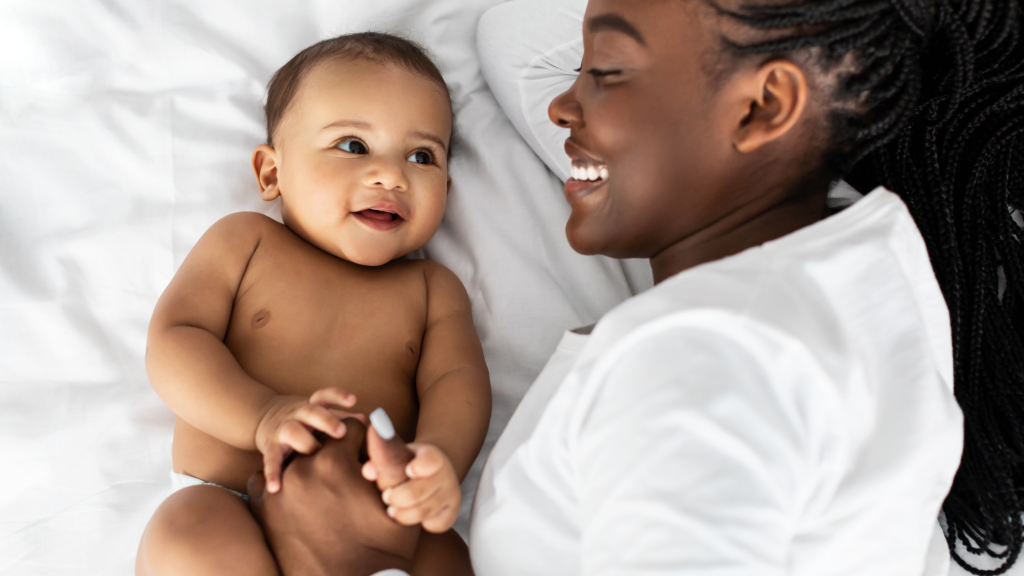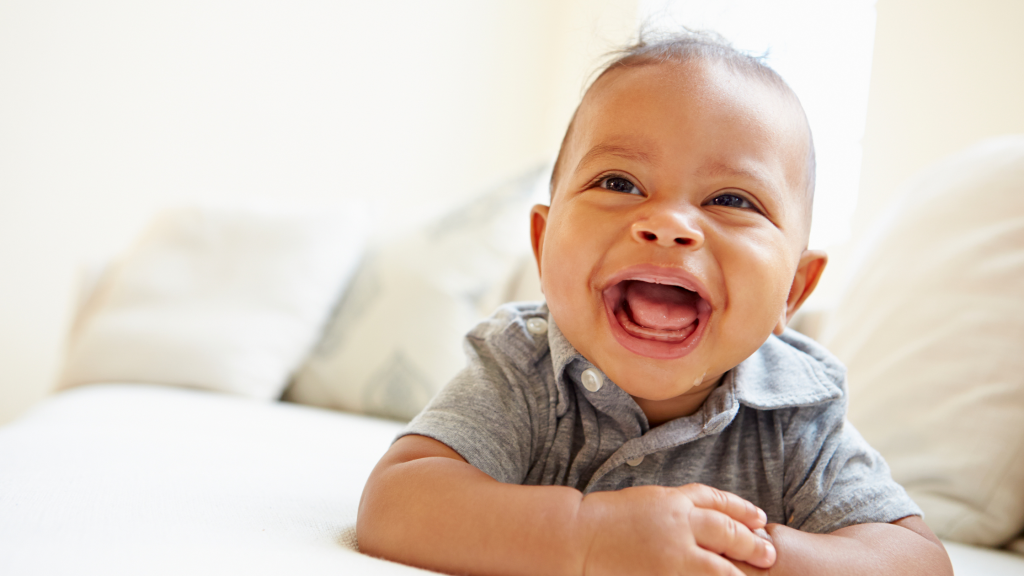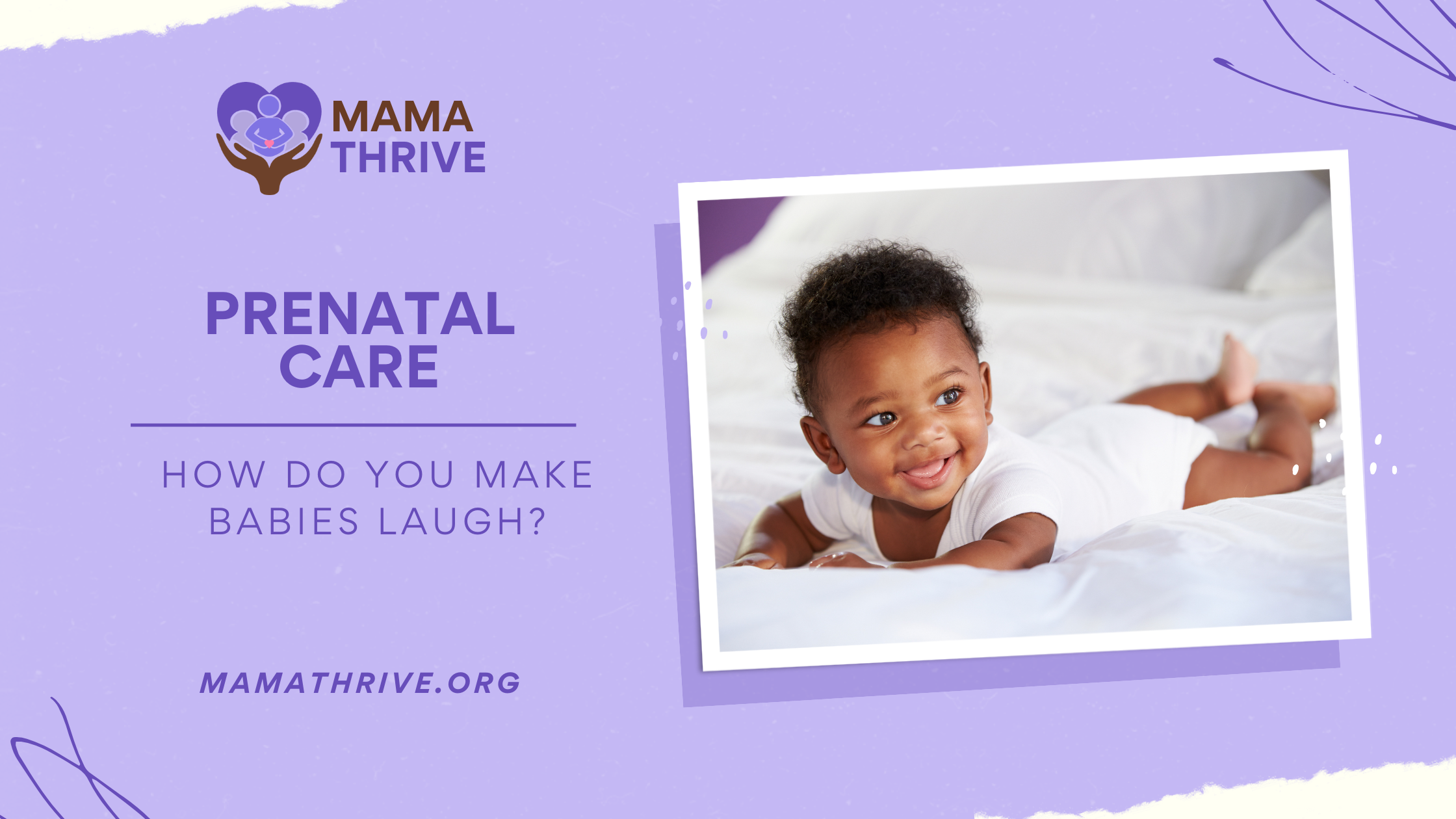Laughter in babies is not only a source of joy for parents and caregivers but also a significant indicator of healthy emotional and social development. Understanding what makes babies laugh involves delving into the realms of developmental psychology and neurology.
Tips to Make Babies Laugh
1. Gentle Tickling
Tickling has been a go-to strategy for generations, known for its almost magical ability to draw laughter from even the most reserved babies. It’s not just about the physical sensation, though. Research delves into how gentle tickling lights up parts of the brain related to pleasure and social bonding. This simple act does more than elicit giggles; it deepens the emotional connection between you and your baby, enhancing the sense of trust and love.
2. Surprising Them
Never underestimate the element of surprise in sparking joyous laughter in your baby. Engaging in classic games like peek-a-boo or suddenly making a silly face can lead to delightful laughter. Researchers discovered that unexpected actions, such as an object vanishing and reappearing, significantly amuse babies. This interaction not only entertains but also aids in their cognitive development, as they begin to grasp new concepts of the world around them.
3. Altering Your Voice
The unique sound of your voice, especially when altered to a higher pitch or imbued with musicality, can captivate and amuse your baby. Studies have shown that infants are particularly responsive to exaggerated vocal tones, finding them both funny and engaging. Moreover, introducing music and rhythmic sounds, characterized by varied pitches and tempos, can be an effective way to stimulate laughter, showcasing a universal love for music and sound from the earliest stages of life.

4. Mimicry
The social nature of laughter becomes evident through interactions that involve mimicry and shared joy. Babies are significantly more likely to laugh when they witness laughter or see others engaging in playful behavior. This indicates that laughter is not solely a reaction to physical touch or stimuli but is deeply intertwined with social interactions and the human instinct for mimicry. Engaging in back-and-forth playful gestures, smiling, and laughing together can create a joyful atmosphere that encourages your baby to join in the laughter, reinforcing the social bonds and shared happiness that form the foundation of their emotional development.
Read more: Laughing Matters: Infant Humor in the Context of Parental Affect
5. Exploring Textures Together
Babies are naturally curious and eager to explore the world around them, including through touch. Introduce your baby to a variety of safe and interesting textures—soft plush toys, cool silk scarves, or even the feel of grass under their fingers. Their unexpected reactions to these new sensations can often turn into bursts of laughter, especially when you express excitement and surprise alongside them.
6. Animal Sounds
Going beyond the typical nursery rhymes and songs, embark on a playful journey of animal sounds. Mimic the moo of a cow, the quack of a duck, or even the less common sounds of animals like a kangaroo or an elephant. The novelty and your animated delivery can be a source of unexpected delight and giggles for your baby.
7. Using Bubbles
While bubbles are a common toy for older children, their magical appeal can also captivate babies. The act of blowing bubbles and watching them float and pop can be a mesmerizing experience. Try gently popping a bubble with your finger or letting one land on your baby’s hand, and watch their astonishment turn into laughter.
8. Funny Movements and Dance
Don’t underestimate the power of silly movements and dance. Put on an upbeat song and let loose with exaggerated, goofy dance moves. Babies not only enjoy watching unusual movements but also the joy and uninhibited fun you express can be contagious, leading to shared laughter and joy.
9. Interactive Reading
Choose brightly illustrated books with interactive elements such as flaps to lift, textures to touch, or sounds to press. Read in an animated voice, making faces and using gestures to bring the story to life. Your baby will love the interaction and the surprise elements of the story, leading to laughter and increased engagement with reading.
Learn about the Surprising Link Between Maternal Nutrition and Baby’s Cognitive Development
10. Shadow Play
Use a flashlight or lamp to create shadow figures on the wall or ceiling, especially during the evening or in a dimly lit room. Simple shapes, your hands forming animals, or even the gentle movement of shadows can intrigue and amuse your baby, eliciting giggles at the playful images dancing before them.
How Do Babies Laugh Develop?

in babies is a fascinating and complex process that intersects the realms of neurology, psychology, and developmental science. The journey from the first smile to the bubbling laughter of an infant offers profound insights into the neurological and emotional development of humans. Let’s delve deeper into this developmental milestone, its variations, and its significance in assessing infant health and development.
Early Signs: Smiling and Laughing
The initial smiles of an infant, often occurring in the first two months, are primarily reflexive and not necessarily a response to external stimuli. These early smiles are seen as a natural part of the baby’s development and are often unrelated to social interactions. However, as the baby’s nervous system matures and they become more aware of their surroundings, smiles become more socially responsive, signaling joy and contentment, often in response to familiar faces or comforting activities.
By the time babies reach 3 to 4 months of age, laughter starts to emerge. This laughter is often in response to physical stimuli, such as tickling or gentle bouncing, or social interactions, like peek-a-boo games or funny faces made by parents and caregivers. This progression from smiling to laughing indicates a significant leap in the baby’s cognitive and social development, as laughter requires a higher level of processing and interaction with the environment.
Variability in Development
It’s crucial to acknowledge the variability in the timeline for these milestones. Some babies may start laughing a bit earlier or later than the 3- to 4-month mark. This variability can be influenced by a range of factors, including individual differences in temperament, the baby’s social environment, and their unique developmental pace. A study published in the journal “Pediatrics” underscores the importance of observing these milestones within a range of normal development, rather than adhering strictly to a specific timeline.
Laughter as a Developmental Marker
The emergence of laughter is a critical marker of neurological development. It signifies not only the maturation of the brain’s areas responsible for processing humor and joy but also the development of social cognition—recognizing and responding to social cues from others. Laughter in response to interaction or play indicates that the baby is engaging with their environment in a meaningful way, a sign of healthy emotional and social development.
Furthermore, the presence or absence of laughter can serve as an early indicator of developmental delays or neurological conditions. If a baby does not show signs of laughter or social smiling within the expected developmental window, it may prompt further assessment by healthcare professionals to identify any underlying issues. Early identification of potential developmental delays is crucial for accessing interventions that can support optimal development.





